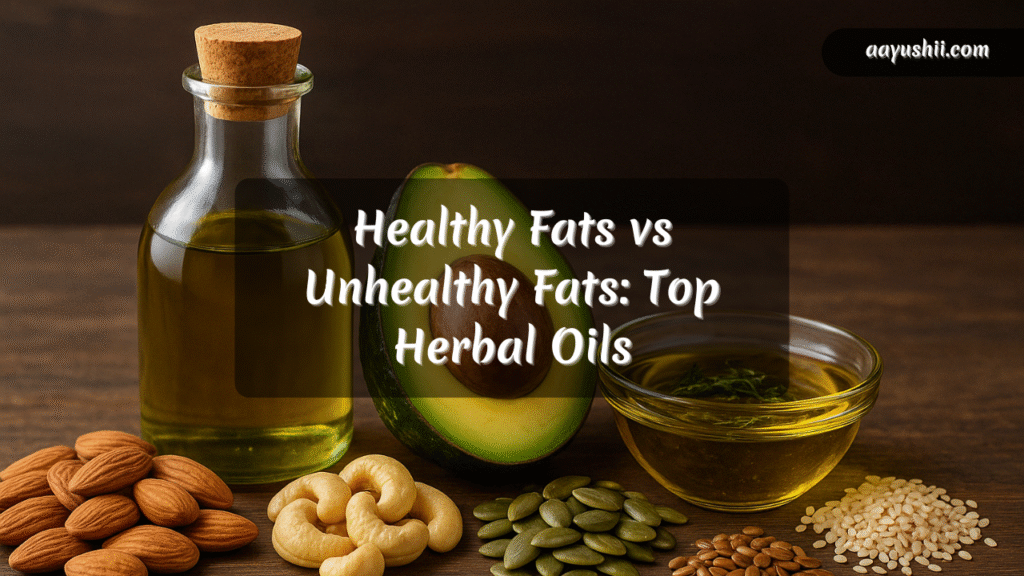Food trends have evolved drastically over the last few decades. From the low-fat craze of the 1980s and 1990s to the current emphasis on the benefits of certain fats, it can be challenging to know exactly which guidelines to follow. Nowadays, nutrition experts emphasize that not all fats are created equal. Some are crucial for proper bodily functions, while others can contribute to diseases if consumed in excess or if they come from unhealthy sources.
One area of growing interest is herbal oils—infusions made by extracting flavors and beneficial properties from various herbs into a base oil. These can add not only flavor but also a range of potential health benefits to dishes. Additionally, the method of cooking and the choice of oil play a significant role in preserving or even enhancing the nutritional properties of your meals.
In this guide, we will delve deeply into the types of fats, focusing on which ones are considered healthy, and which ones may pose risks. We will also explore some of the best herbal oils, their potential advantages, and how to use them in practical, everyday cooking. By the end of this article, you should feel confident about making informed decisions regarding dietary fats and be excited to incorporate flavorful herbal oils into your culinary repertoire.
Table of Contents
What Are Fats?
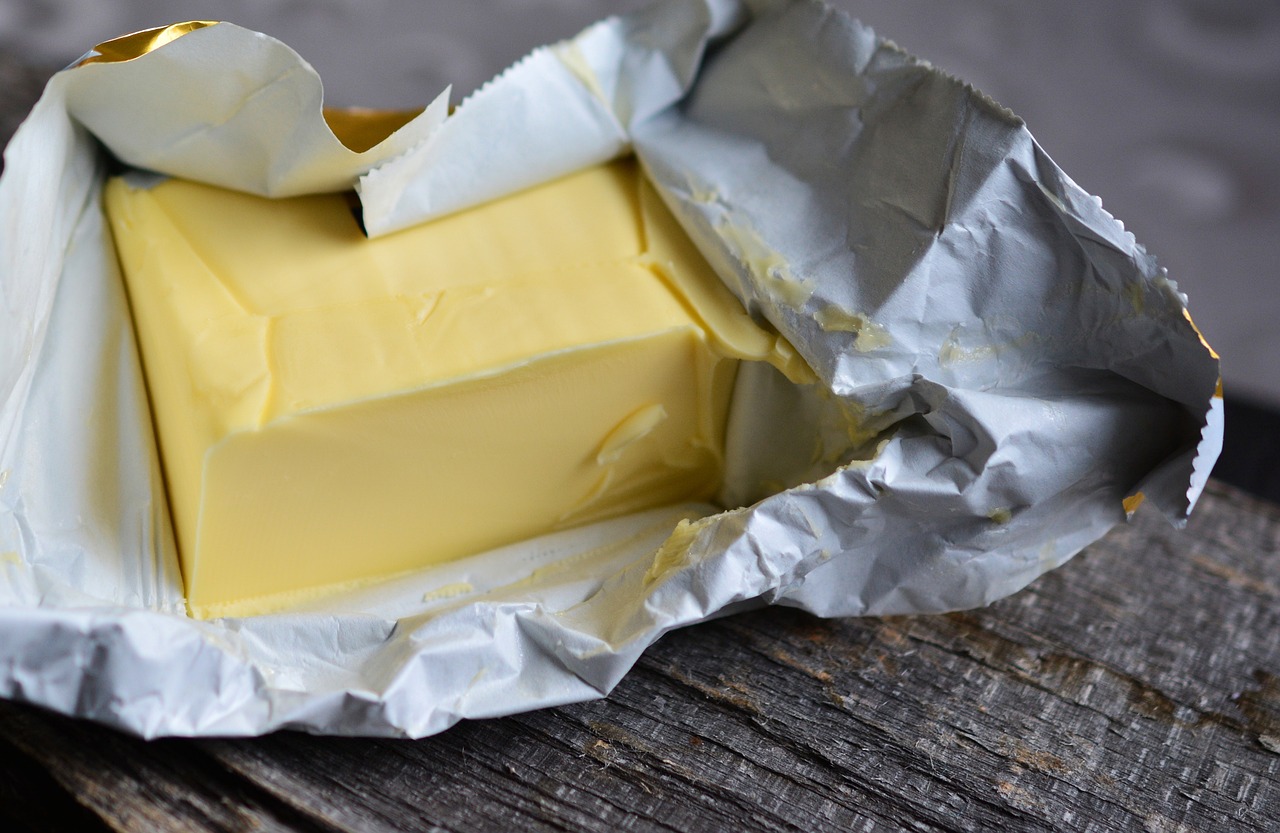
At the most basic level, fats are a macronutrient. Along with protein and carbohydrates, they provide essential fuel for the body. Chemically, fats are composed of fatty acids attached to a glycerol backbone, forming molecules called triglycerides. The structure and type of these fatty acids determine whether a fat is saturated, monounsaturated, polyunsaturated, or trans.
Although fat has historically been demonized in many diets, it is actually indispensable for a variety of bodily functions, including:
- Hormone production
- Absorption of fat-soluble vitamins (A, D, E, and K)
- Providing a concentrated source of energy
- Supporting cell growth and maintenance
Understanding the types of fats and their roles is the first step in determining how to incorporate healthier options into your diet.
Why Do We Need Fats?
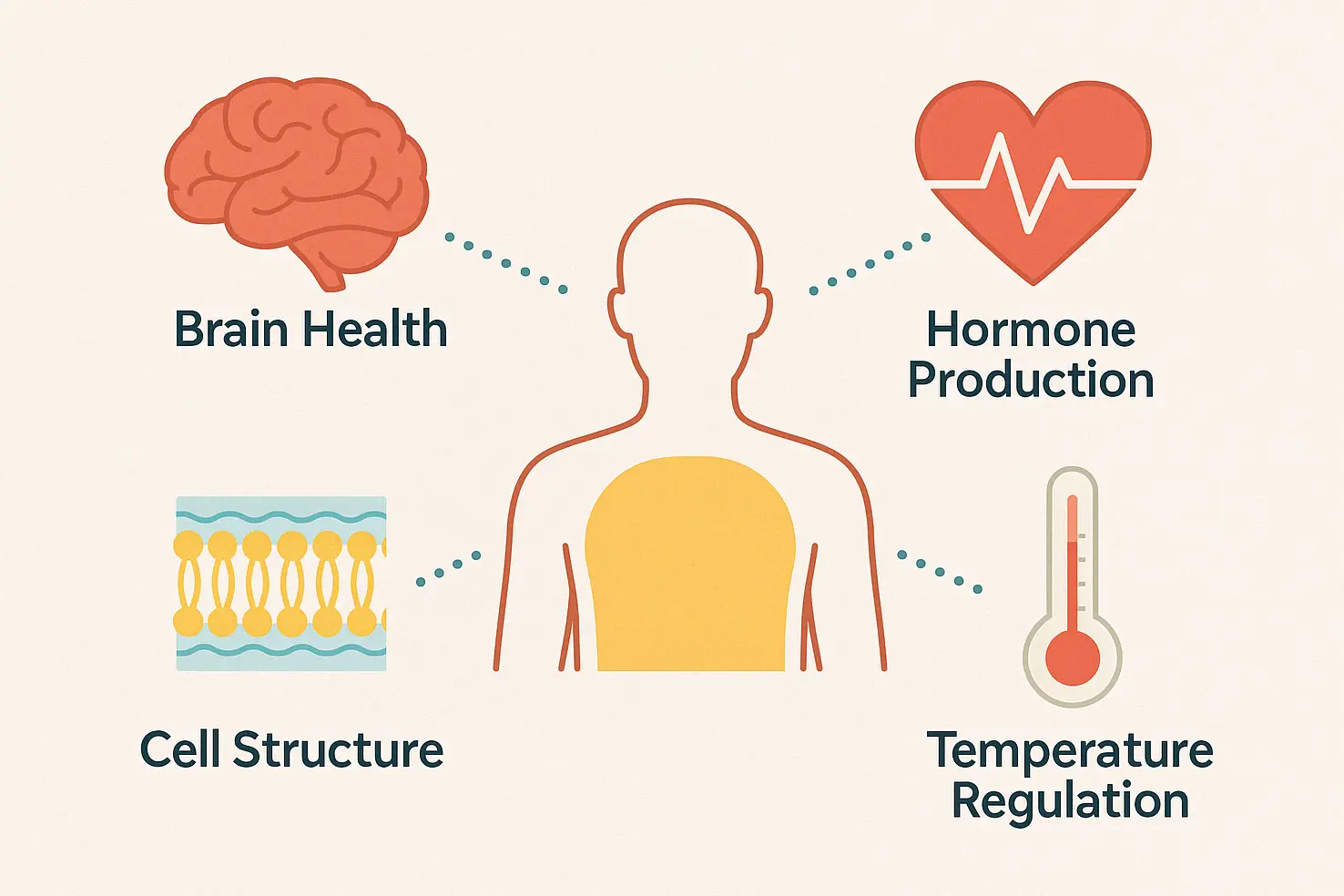
While many people focus on the dangers of high-fat diets, fats themselves are not inherently bad. In fact, they are necessary for survival. Here are several critical reasons why the body needs fats:
- Energy Source: Fats provide more than double the amount of energy (9 calories per gram) compared to protein or carbohydrates (4 calories per gram). This makes them a highly efficient source of fuel.
- Hormonal Balance: Certain hormones, especially sex hormones such as estrogen and testosterone, are synthesized from cholesterol, a waxy substance derived from some fats.
- Vitamin Absorption: Vitamins A, D, E, and K are fat-soluble, meaning they require the presence of fat to be properly absorbed and utilized by the body.
- Cell Membrane Integrity: The membranes of cells throughout the body contain fats (particularly phospholipids). These fats help regulate which substances can enter or exit the cell.
- Insulation and Protection: Fats help insulate the body against temperature changes and provide cushioning for vital organs.
The key is consuming the right kind of fats in proper proportions.
Types of Dietary Fats
The dietary fats we consume can be broadly classified into several categories based on their chemical structure and effects on the body. Understanding these differences is critical to making healthier eating choices.
Saturated Fats
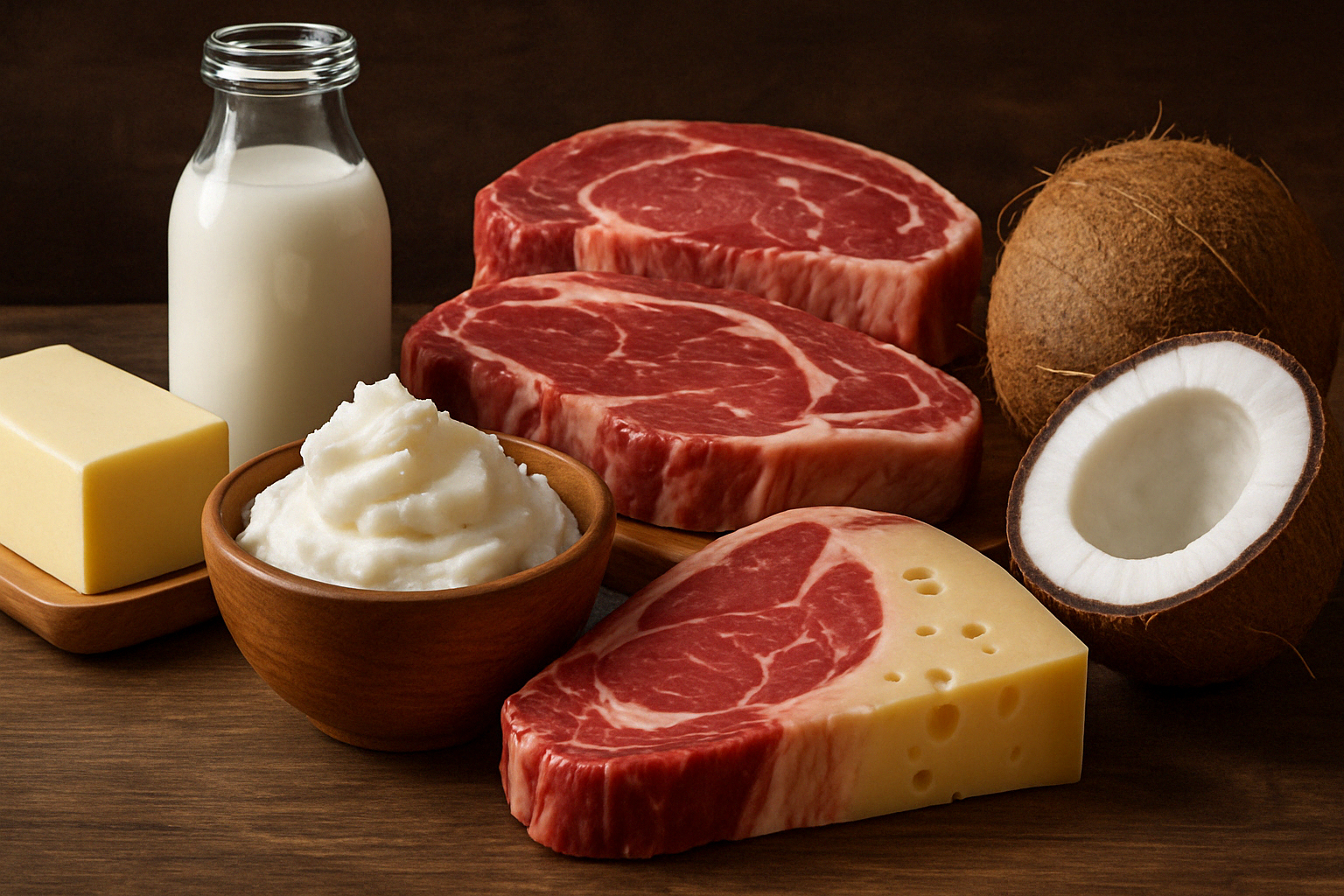
Saturated fats have all of their carbon atoms “saturated” with hydrogen. These fats are typically solid at room temperature. Common dietary sources include:
- Red meat (beef, pork, lamb)
- Dairy products (full-fat cheese, butter)
- Coconut oil and palm oil
In the past, saturated fats were strongly associated with heart disease. Current research indicates that while moderate consumption of saturated fats may not be as harmful as once believed, excessive intake can still raise LDL (“bad”) cholesterol levels in many individuals. Balancing saturated fats with unsaturated fats is generally recommended for overall heart health.
Unsaturated Fats
Unsaturated fats have at least one double bond in their chemical structure, meaning they are not fully saturated with hydrogen atoms. They are usually liquid at room temperature and are considered healthier than saturated fats when consumed in moderation.
Monounsaturated Fats
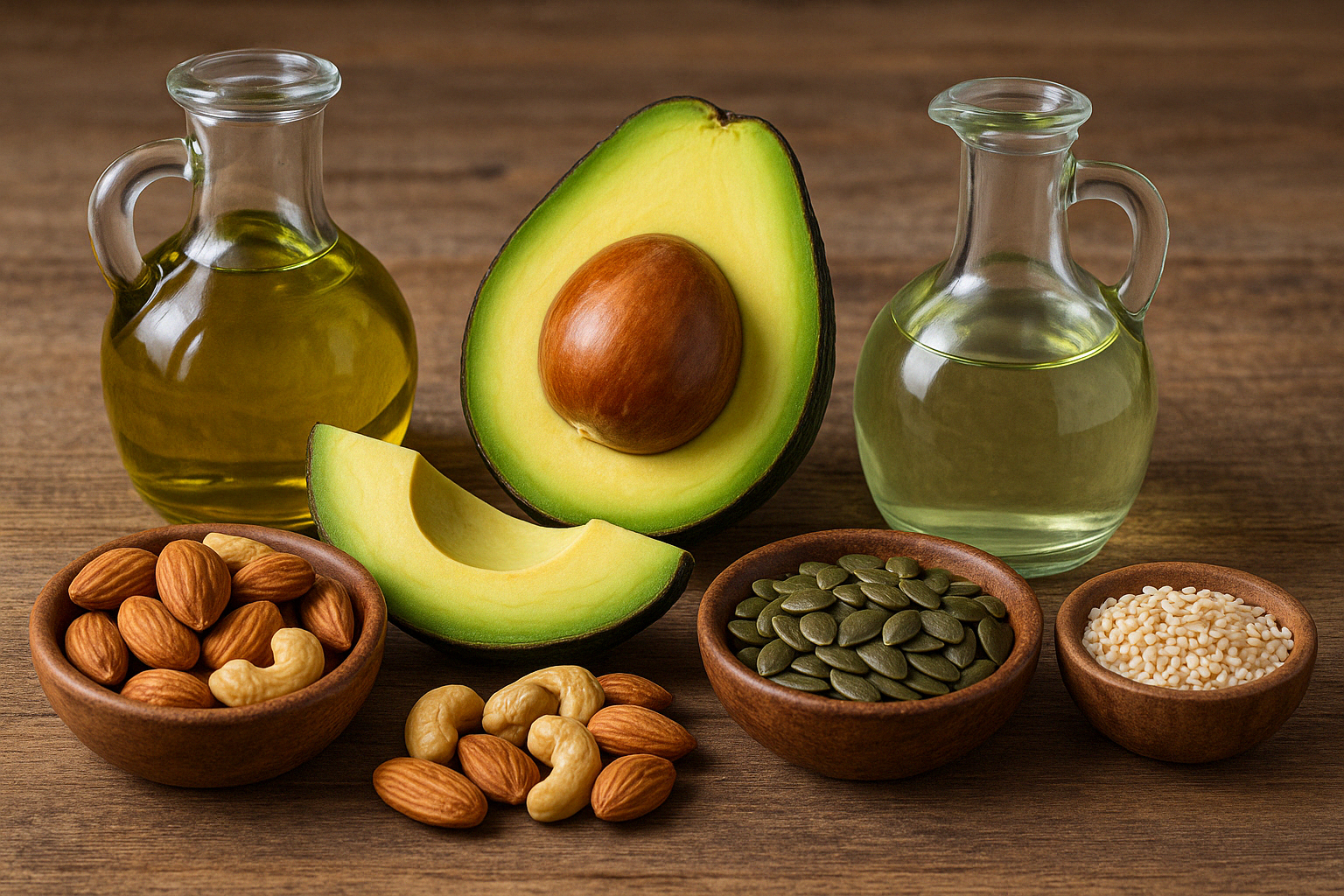
Monounsaturated fats (MUFAs) have one double bond in their structure. Common dietary sources include:
- Olive oil
- Avocado oil
- Nuts (almonds, cashews, hazelnuts)
- Seeds (pumpkin seeds, sesame seeds)
MUFAs have been associated with improved heart health, better insulin sensitivity, and reduced inflammation. Diets high in monounsaturated fats, such as the Mediterranean diet, are often linked to lower rates of chronic diseases.
Polyunsaturated Fats
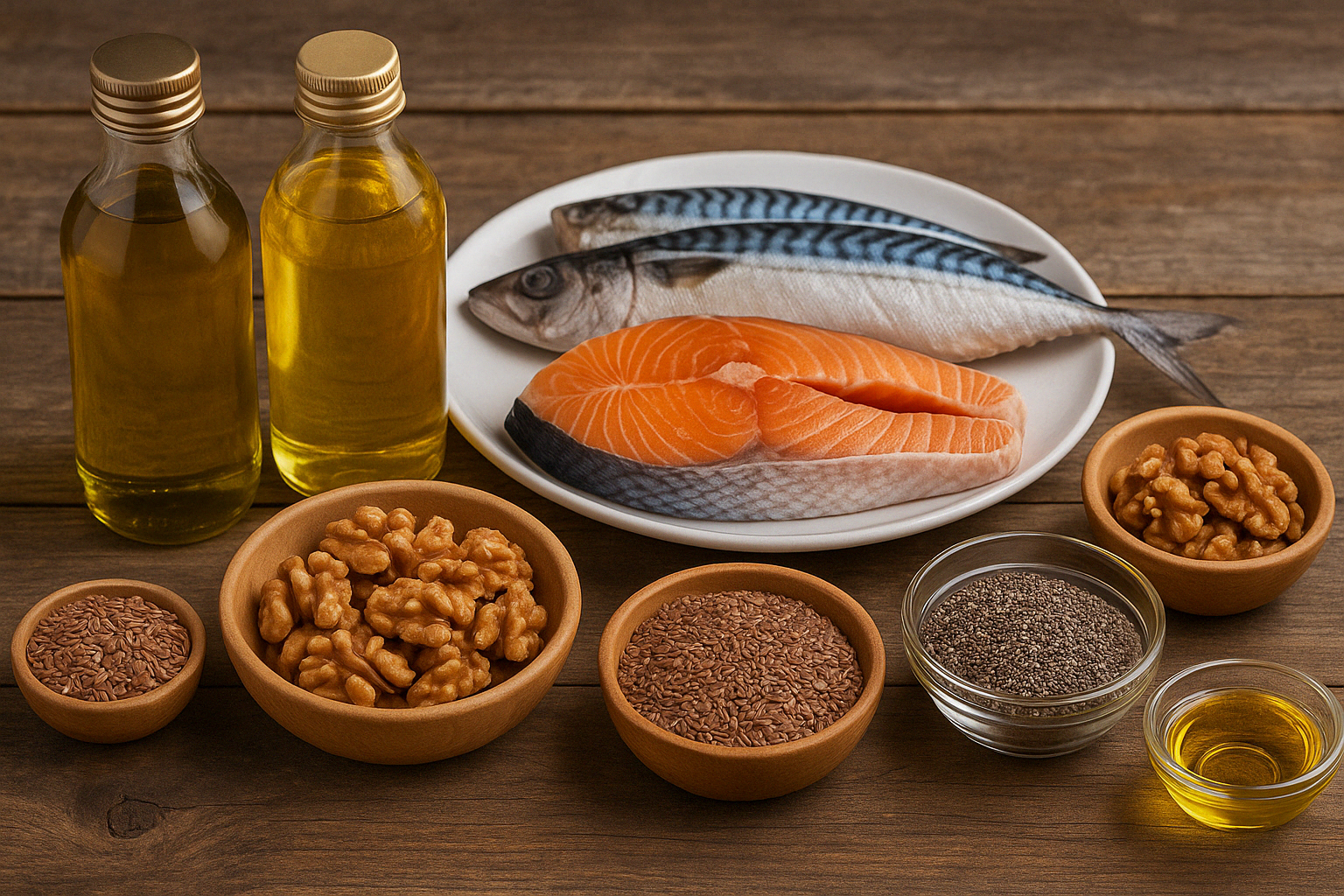
Polyunsaturated fats (PUFAs) have multiple double bonds in their structure. They include essential fatty acids that the body cannot produce on its own, such as omega-3 and omega-6 fatty acids. Food sources rich in polyunsaturated fats include:
- Fatty fish (salmon, mackerel, sardines)
- Flaxseeds and chia seeds
- Walnuts
- Soybean oil
- Corn oil
These fats are recognized for their potential benefits in reducing inflammation, improving heart health, and supporting brain function. However, it is important to maintain a balance between omega-3 and omega-6 fatty acids to avoid excessive inflammation.
Trans Fats
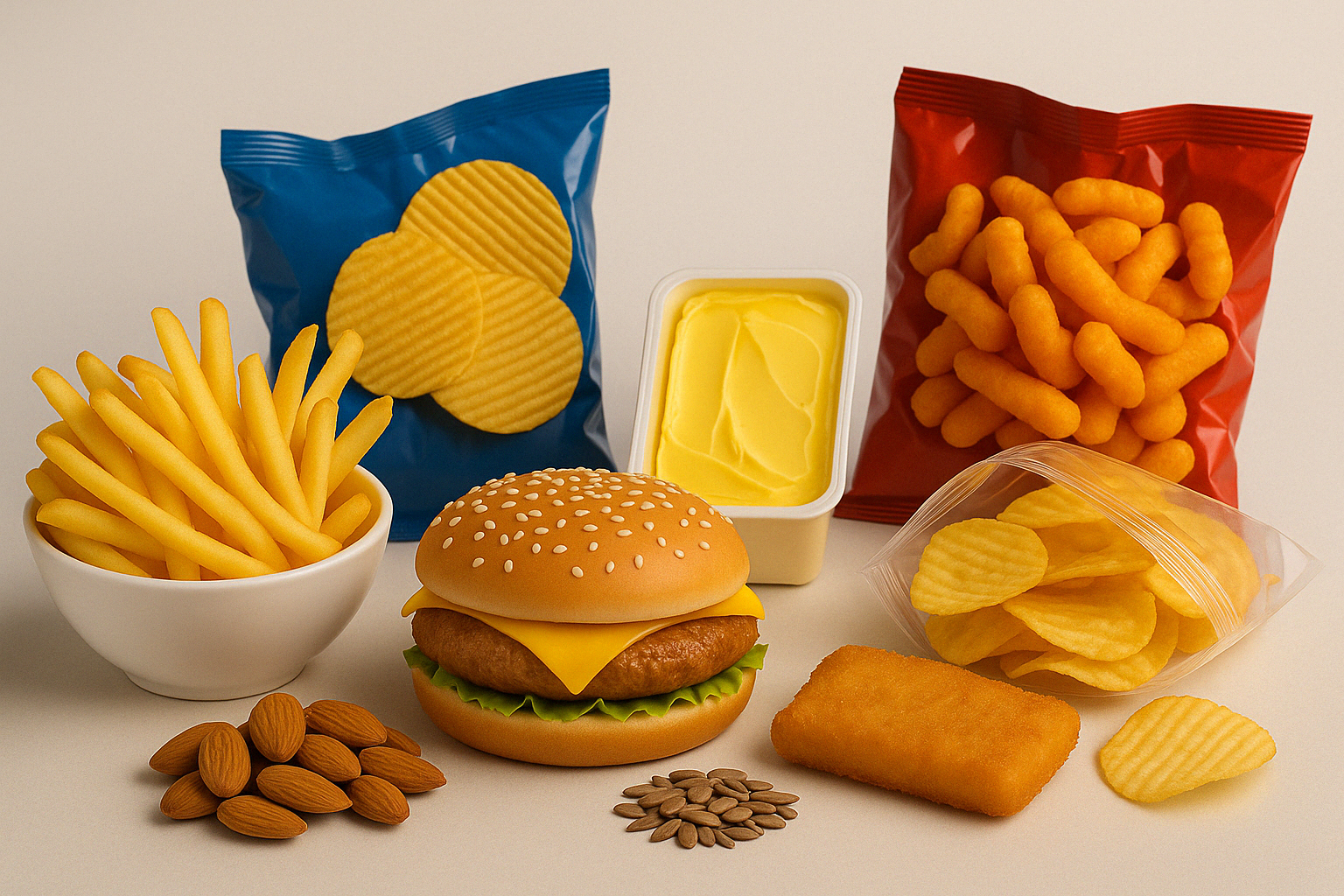
Trans fats are unsaturated fats that have been chemically altered through a process called hydrogenation, which makes them more solid and shelf-stable. Historically, they have been used extensively in processed foods, margarine, and fast foods to enhance texture and longevity.
Trans fats are widely considered the most harmful type of fat because they can both increase LDL (“bad”) cholesterol and lower HDL (“good”) cholesterol. Many countries have taken steps to ban or severely limit the use of artificial trans fats. It is best to avoid them as much as possible by reading labels and choosing minimally processed foods.
Healthy Fats vs Unhealthy Fats
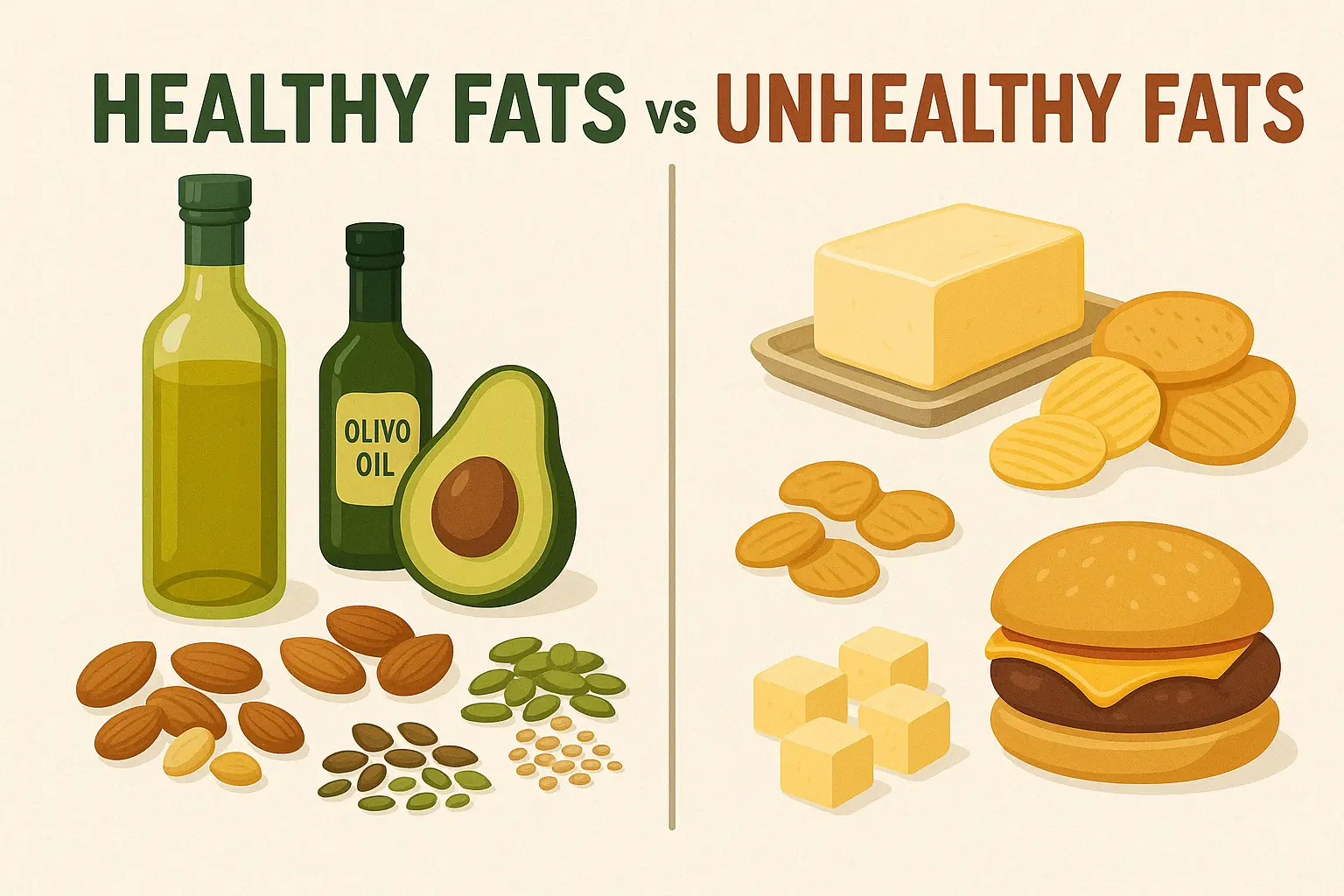
The categorization of healthy vs. unhealthy fats is not always straightforward. However, the consensus among nutrition experts is generally:
- Healthy fats: Monounsaturated and polyunsaturated fats (particularly those containing omega-3 fatty acids) are considered beneficial. They support heart health, hormone regulation, cognitive function, and reduce inflammation.
- Moderately healthy fats: Saturated fats can be part of a balanced diet if consumed in moderation and if overall dietary pattern is healthy.
- Unhealthy fats: Trans fats are considered harmful and should be avoided as much as possible.
When selecting fat sources, prioritize foods like avocados, nuts, seeds, fatty fish, and plant oils that are high in unsaturated fats. Try limiting your intake of heavily processed foods that often contain trans fats and excessive saturated fats.
Common Sources of Healthy Fats
To ensure you are getting high-quality healthy fats, consider adding the following to your diet:
Avocados
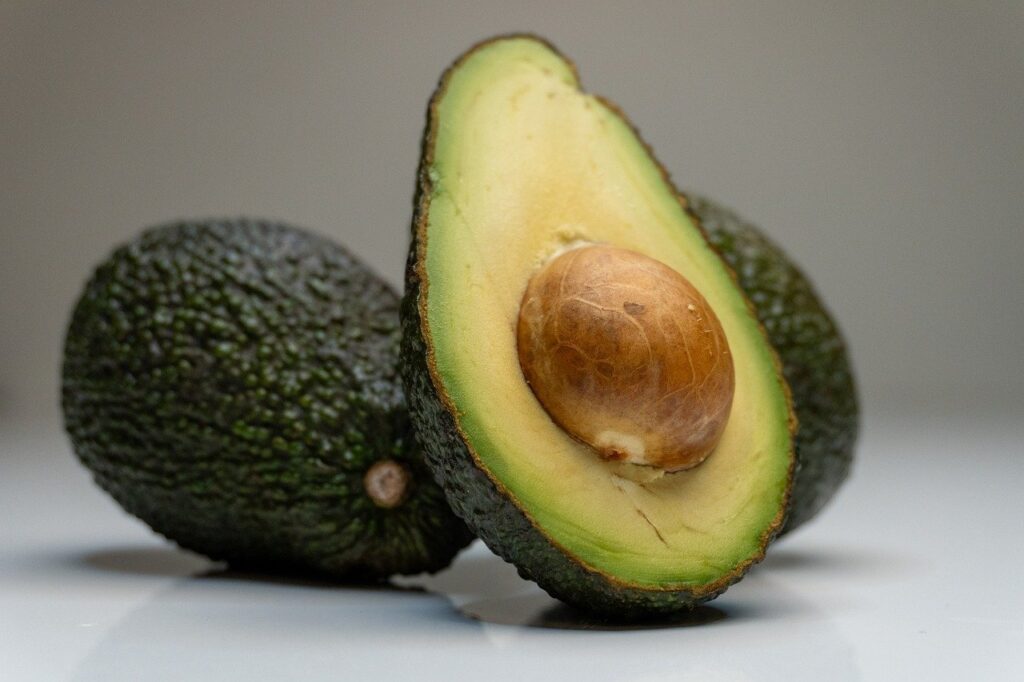
Avocados are rich in monounsaturated fats, fiber, and various vitamins and minerals. They can be mashed into guacamole, sliced on toast, or used in smoothies for added creaminess.
Nuts and Seeds
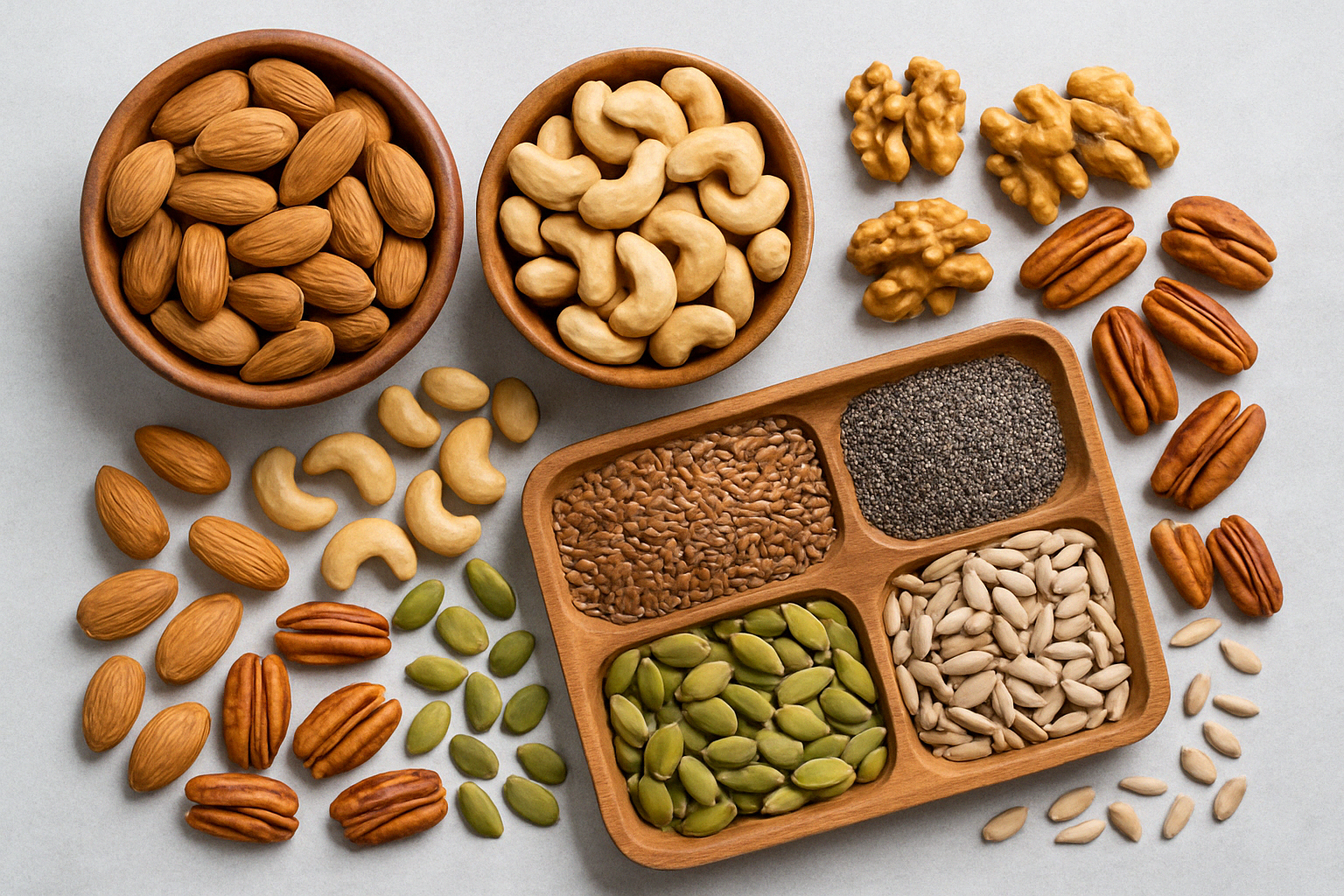
- Almonds, cashews, walnuts, pistachios, and pecans offer a great source of monounsaturated and polyunsaturated fats.
- Flaxseeds, chia seeds, pumpkin seeds, and sunflower seeds are excellent sources of omega-3 fatty acids (particularly flax and chia) and other nutrients.
Fatty Fish
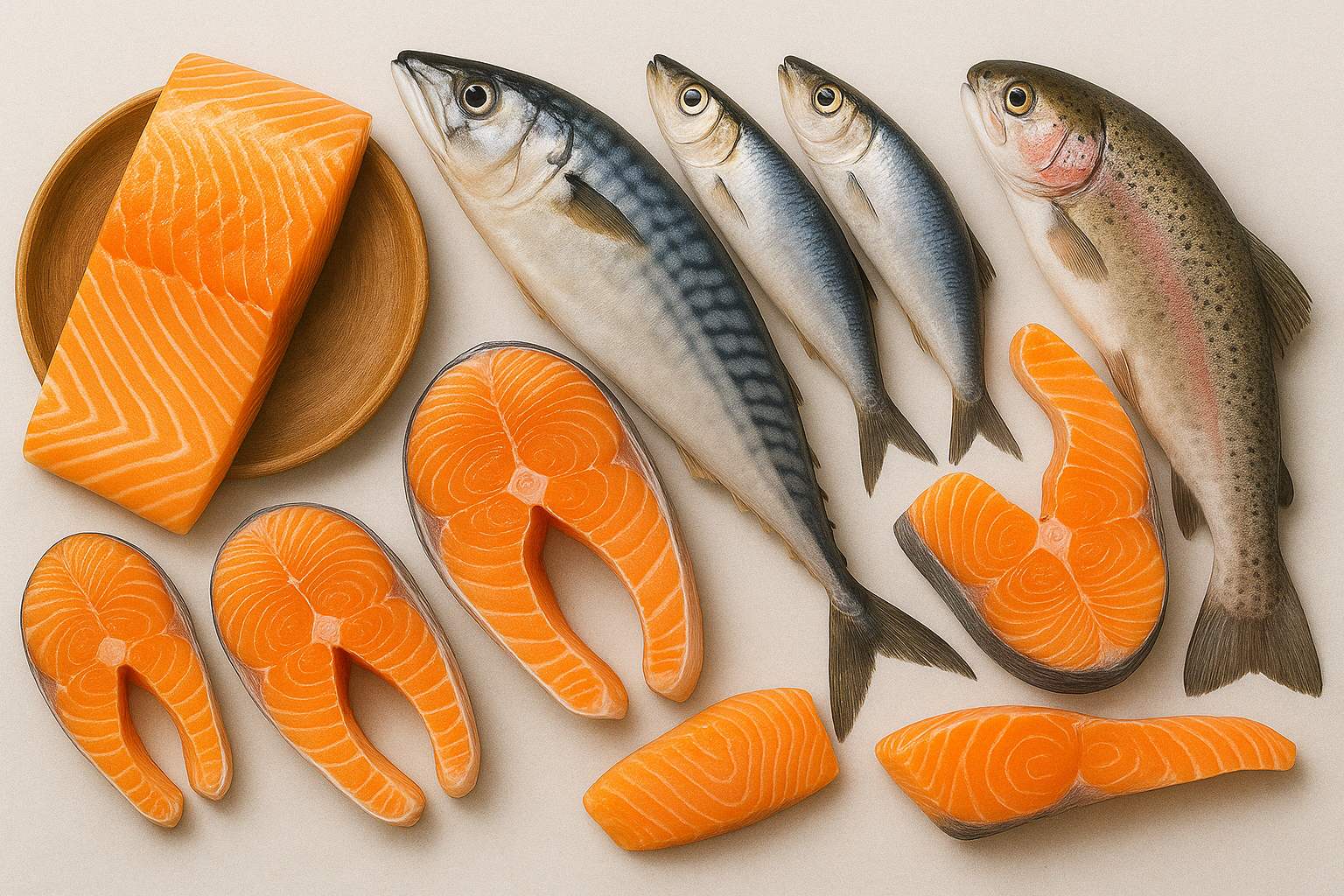
Salmon, mackerel, sardines, and trout are loaded with essential omega-3 fatty acids (EPA and DHA). These nutrients are vital for brain function, reducing inflammation, and supporting heart health.
Olives and Olive Oil

Both olives and olive oil provide monounsaturated fats. Extra virgin olive oil (EVOO) is especially valued for its antioxidants and anti-inflammatory compounds.
Soybeans and Tofu
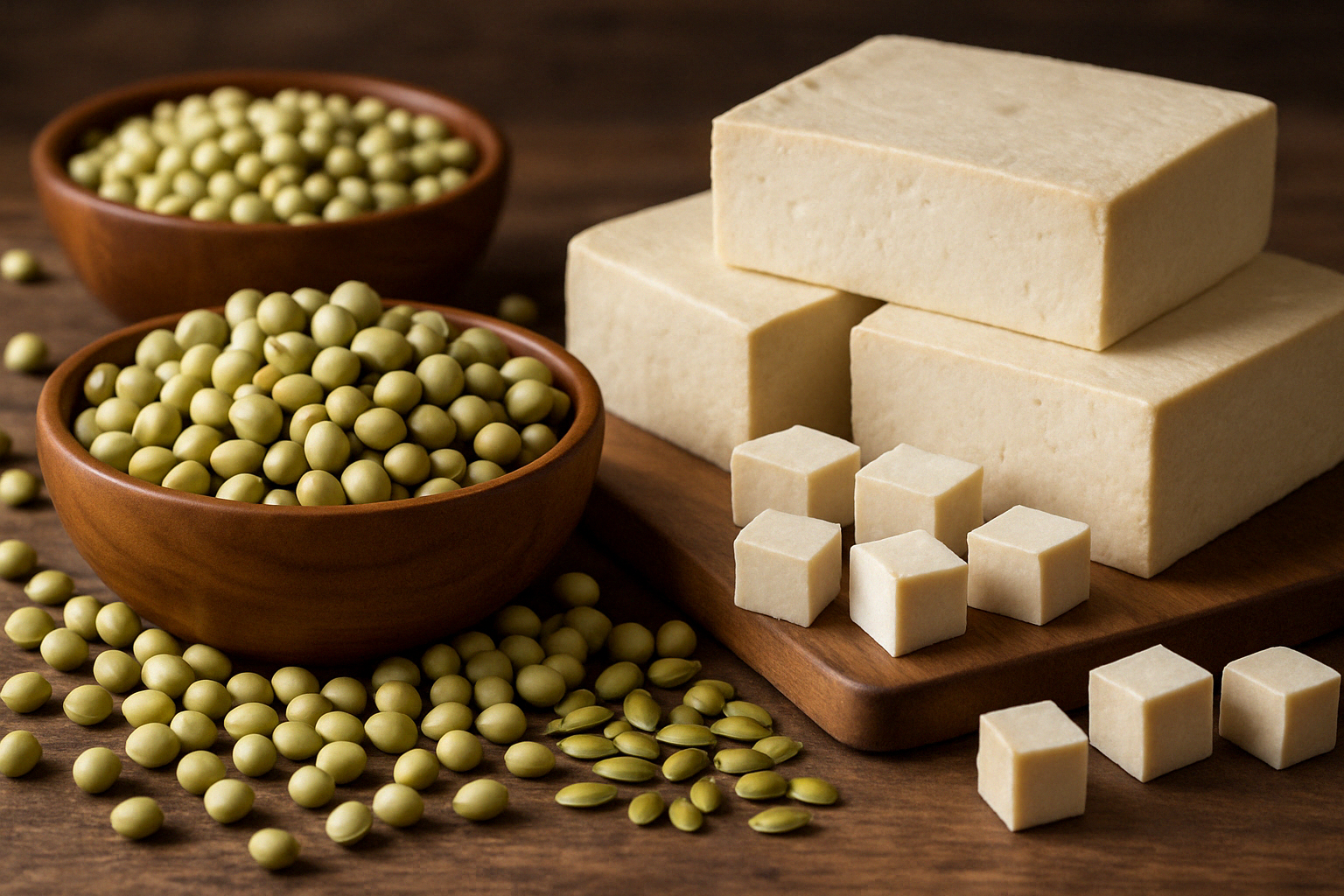
Soy-based foods contain polyunsaturated fats, including omega-6 fatty acids, and can be part of a healthy diet. Moderation and variety is key, as it is with all foods.
Eggs

While eggs do contain cholesterol, they also provide a range of nutrients, including healthy fats in the yolk. Many nutritionists now recommend including eggs in a balanced diet.
Introduction to Herbal Oils
When most people think of cooking oils, they picture vegetable oils, olive oil, or perhaps butter. However, there is a growing interest in herbal oils—oils that are infused with the flavors and potential health benefits of herbs, spices, or aromatics. Examples include rosemary-infused olive oil, basil-infused avocado oil, or oregano-infused grapeseed oil.
These herbal oils can be homemade or purchased commercially. They add delightful layers of flavor to dishes, from salad dressings to sautés, and may also carry some of the beneficial properties of the herbs themselves, such as antioxidant or anti-inflammatory compounds.
Popular Herbal Oils and Their Benefits
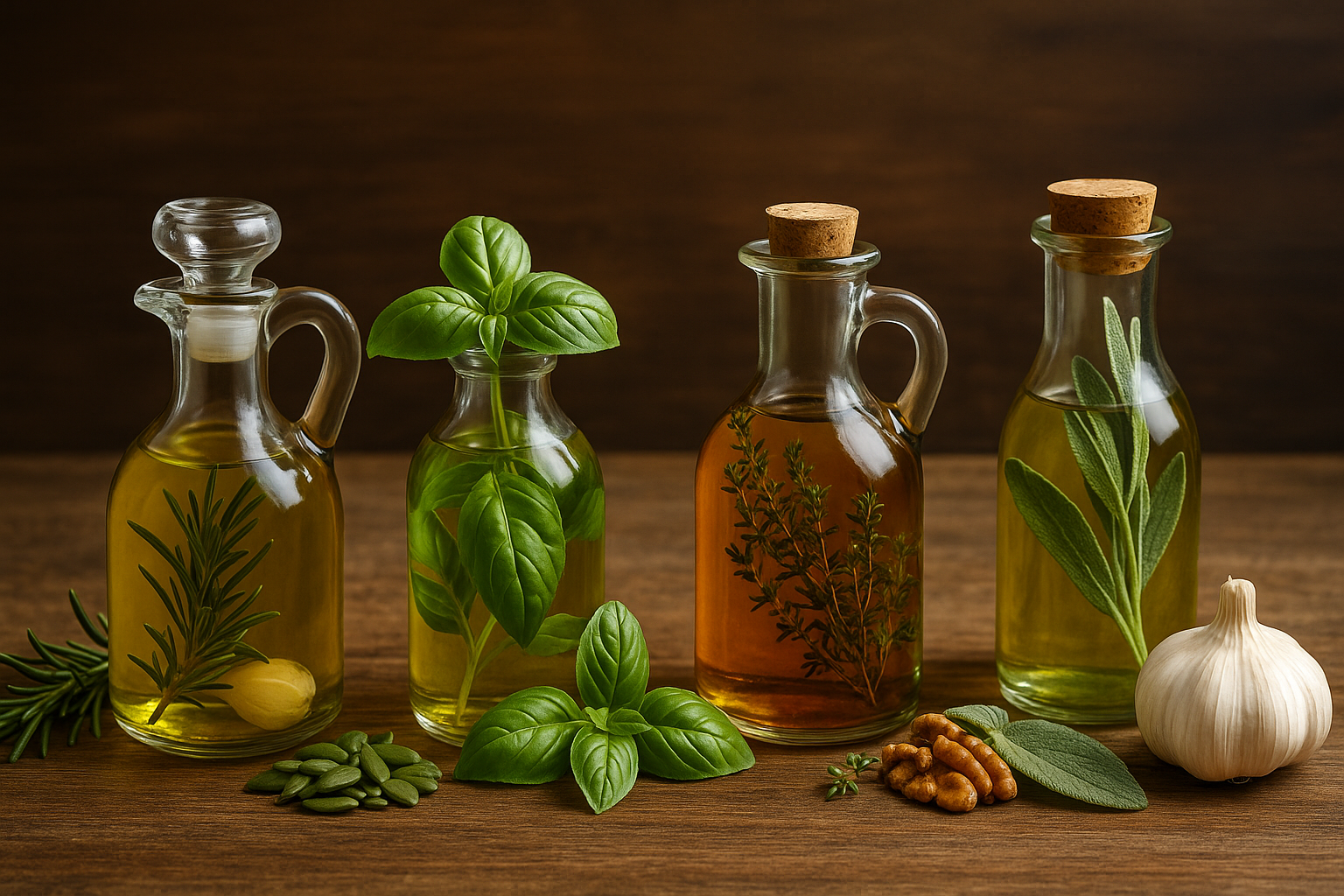
Herbal oils generally start with a base oil high in unsaturated fats (often olive, avocado, or grapeseed oil), which is then combined with one or more fresh or dried herbs. Below are some popular herbal oils and what they bring to the table.
Rosemary Oil
- Flavor Profile: Piney, earthy aroma with a slightly minty taste.
- Potential Benefits:
- May have antioxidant properties that help neutralize free radicals.
- Traditionally associated with improving focus and memory.
- Culinary Uses: Ideal for roasting potatoes, chicken, or lamb. Also works well in homemade bread dough or infused in dipping oils.
Basil Oil
- Flavor Profile: Sweet, slightly peppery flavor with hints of mint and anise.
- Potential Benefits:
- Basil contains eugenol, a compound that may help reduce inflammation.
- Rich in vitamins and minerals, though much of the nutrition is used in synergy with a balanced diet.
- Culinary Uses: Drizzle over pizzas or pasta dishes, use as a base for salad dressings, or blend into sauces such as pesto.
Oregano Oil
- Flavor Profile: Strong, warm, and slightly bitter taste.
- Potential Benefits:
- Oregano contains carvacrol and thymol, compounds thought to have antimicrobial and antioxidant properties.
- May help support immune function when used as part of a balanced diet.
- Culinary Uses: Perfect for Mediterranean-inspired dishes, marinades, and robust tomato sauces.
Thyme Oil
- Flavor Profile: A bit sharp and earthy, with minty undertones.
- Potential Benefits:
- Thyme is another herb high in antioxidants.
- Contains thymol, which may have antiseptic properties.
- Culinary Uses: Great for meats, soups, stews, and roasted vegetables.
Other Herbal Infusions
You can experiment with an endless variety of herbs such as parsley, cilantro, chives, dill, or even spices like chili flakes, peppercorns, or garlic. The possibilities are almost endless:
- Garlic-infused oil for a robust, savory kick.
- Chili-infused oil for spicy flavor in stir-fries and sauces.
- Cilantro or parsley-infused oil for a fresh, bright touch to drizzle over grilled fish or roasted vegetables.
Best Cooking Oils and Their Smoke Points
When choosing an oil for cooking, one critical factor to consider is the smoke point—the temperature at which the oil begins to break down and produce smoke. When an oil surpasses its smoke point, it can produce harmful free radicals and a burnt, bitter flavor. Below are some popular oils, their approximate smoke points, and suggested culinary uses.
Olive Oil (Extra Virgin, Virgin, and Light)
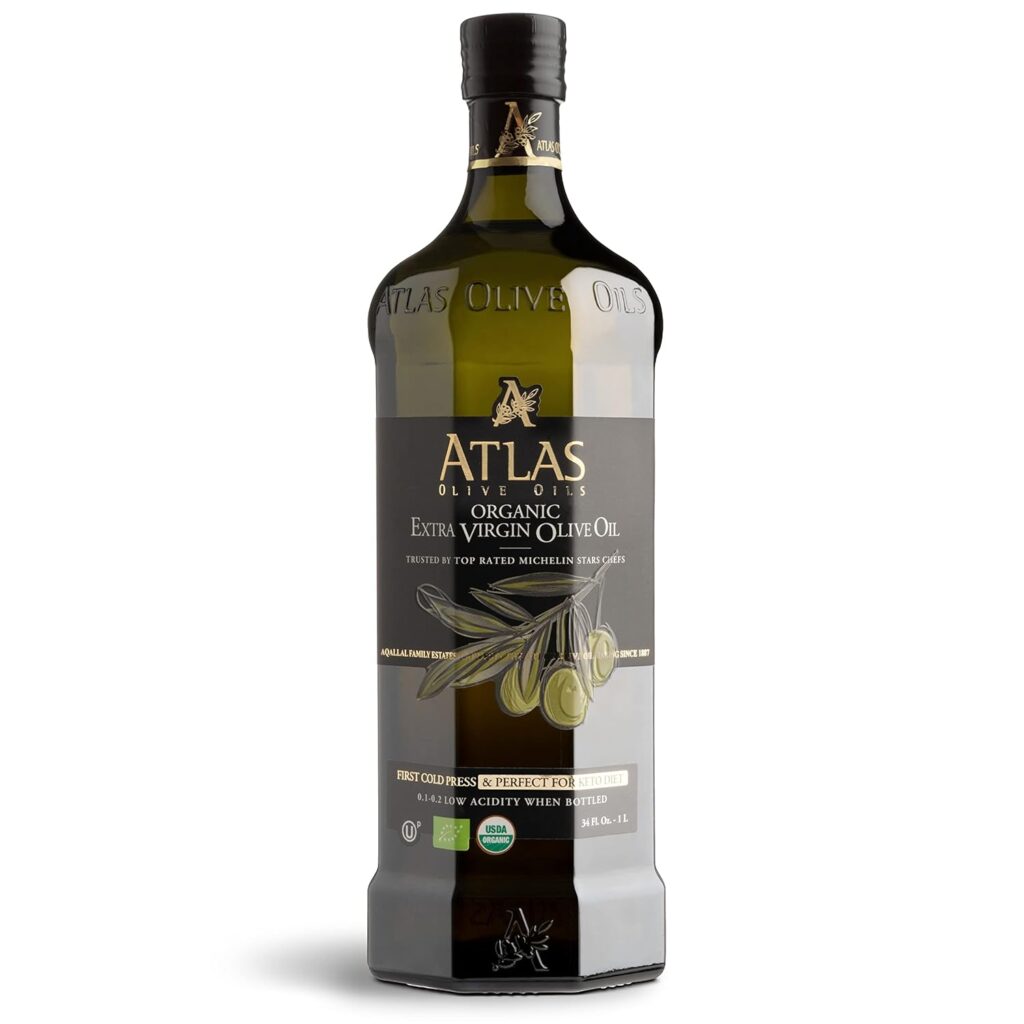
- Smoke Point:
- Extra Virgin: around 375°F (190°C)
- Virgin: about 420°F (215°C)
- Light/Refined: up to 465°F (240°C)
- Flavor Profile: Ranges from fruity and peppery to mild depending on the quality and region.
- Nutritional Benefits: High in monounsaturated fats and antioxidants.
- Best Uses:
- Extra virgin: Salad dressings, drizzling over finished dishes, low-heat cooking.
- Virgin: Medium-heat sautéing and stir-frying.
- Light/Refined: Baking, high-heat sautéing, and frying.
Avocado Oil
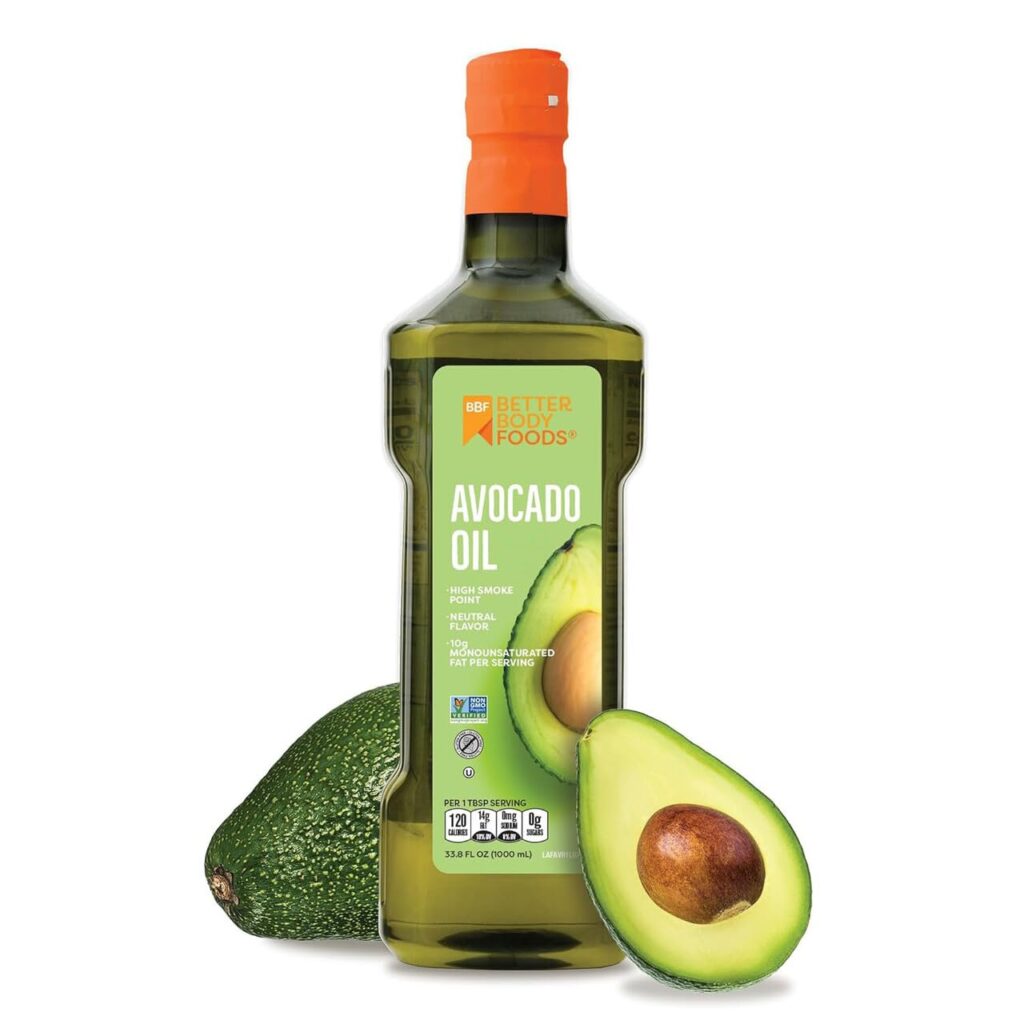
- Smoke Point: Approximately 520°F (271°C), one of the highest among commonly used culinary oils.
- Flavor Profile: Mild, slightly buttery taste.
- Nutritional Benefits: Rich in monounsaturated fats, vitamin E, and lutein.
- Best Uses: Ideal for high-heat cooking methods like frying, roasting, and grilling. Also great for dressings due to its neutral flavor.
Coconut Oil
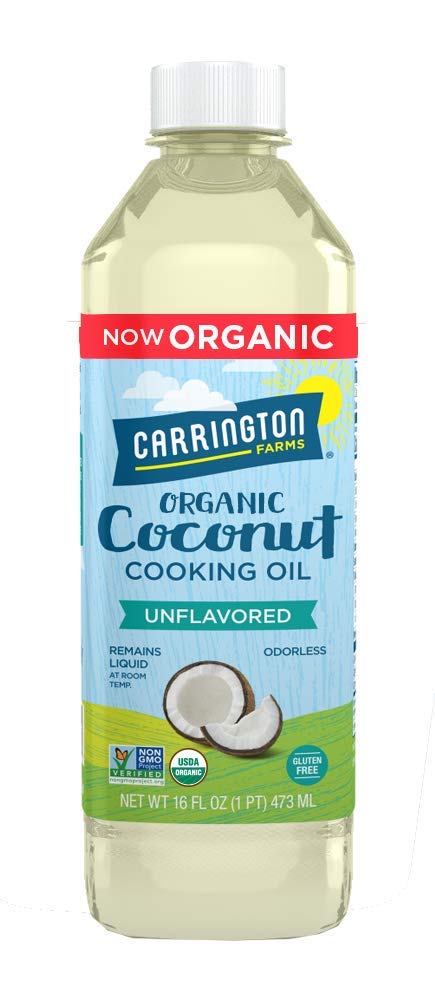
- Smoke Point: Unrefined coconut oil about 350°F (177°C); refined coconut oil around 400°F (204°C).
- Flavor Profile: Unrefined coconut oil has a distinct coconut taste; refined is more neutral.
- Nutritional Benefits: Primarily contains saturated fats (lauric acid). Some research suggests it may have antimicrobial properties.
- Best Uses:
- Unrefined: Low to medium-heat cooking, baking.
- Refined: Medium-heat cooking, sautéing.
- Note: Due to its high saturated fat content, it’s best used in moderation.
Sesame Oil
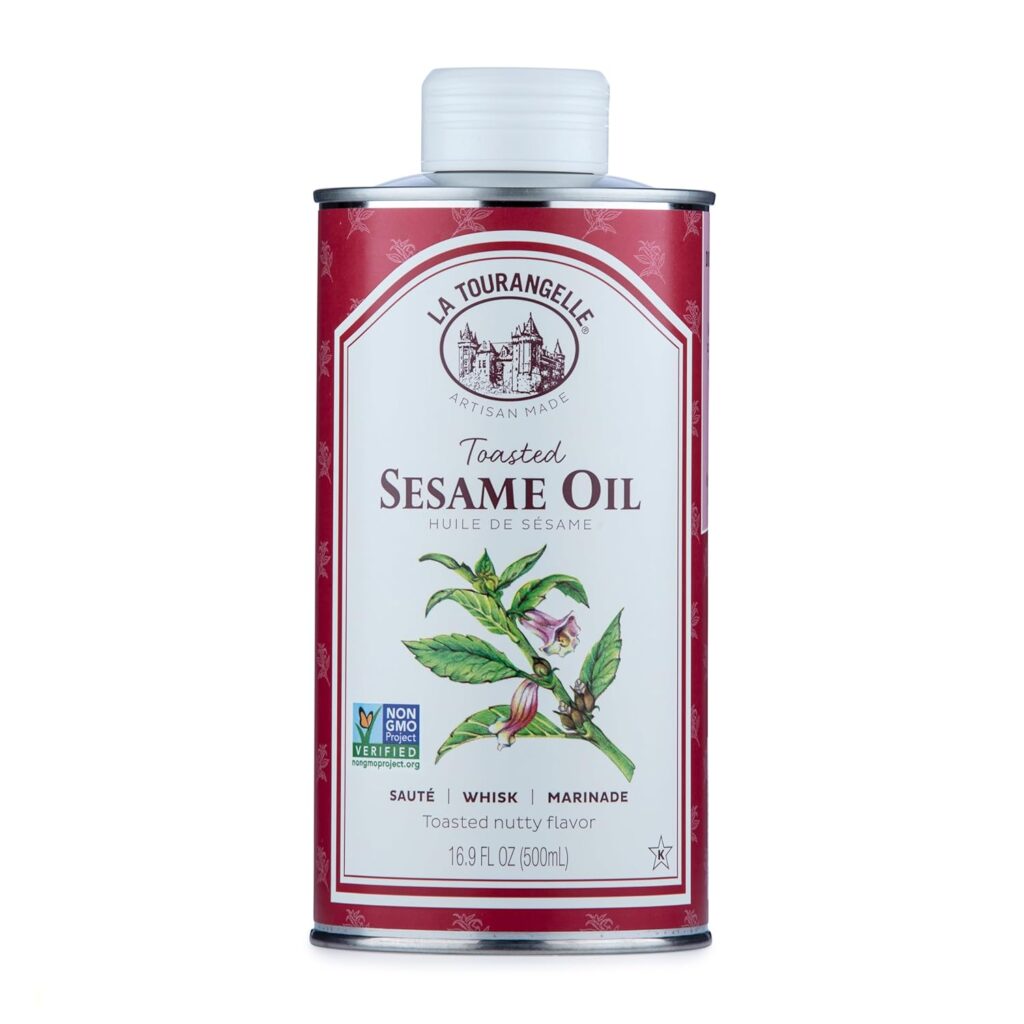
- Smoke Point: Unrefined around 350°F (177°C); refined up to 450°F (232°C).
- Flavor Profile: Nutty and aromatic, especially toasted sesame oil.
- Nutritional Benefits: Contains both monounsaturated and polyunsaturated fats, as well as antioxidants like sesamol.
- Best Uses:
- Toasted sesame oil: Finishing drizzle for stir-fries, marinades, or dressings.
- Refined sesame oil: Stir-frying and medium-heat cooking.
Peanut Oil
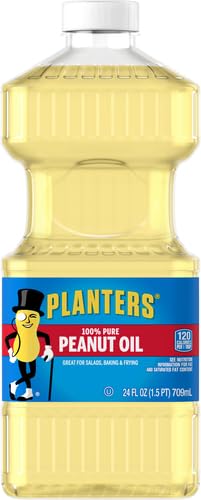
- Smoke Point: About 450°F (232°C) for refined peanut oil.
- Flavor Profile: Subtle nutty taste (refined peanut oil is milder than unrefined).
- Nutritional Benefits: High in monounsaturated fats and vitamin E.
- Best Uses: Deep-frying (often used in Asian cuisines), high-heat stir-fries, frying.
Grapeseed Oil
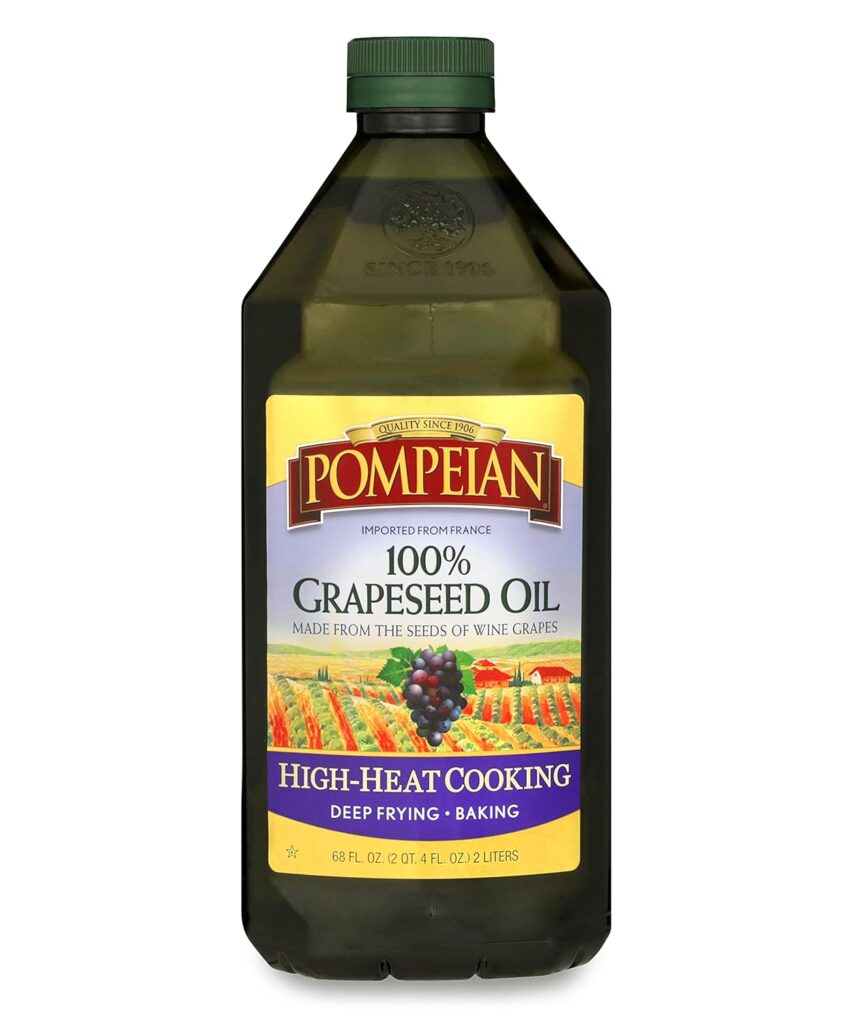
- Smoke Point: Around 420°F (215°C).
- Flavor Profile: Very mild, almost neutral flavor.
- Nutritional Benefits: Contains vitamin E and polyunsaturated fats, especially omega-6 fatty acids.
- Best Uses: Excellent for sautéing, stir-frying, and for use in salad dressings or herbal infusions.
Sunflower and Safflower Oils
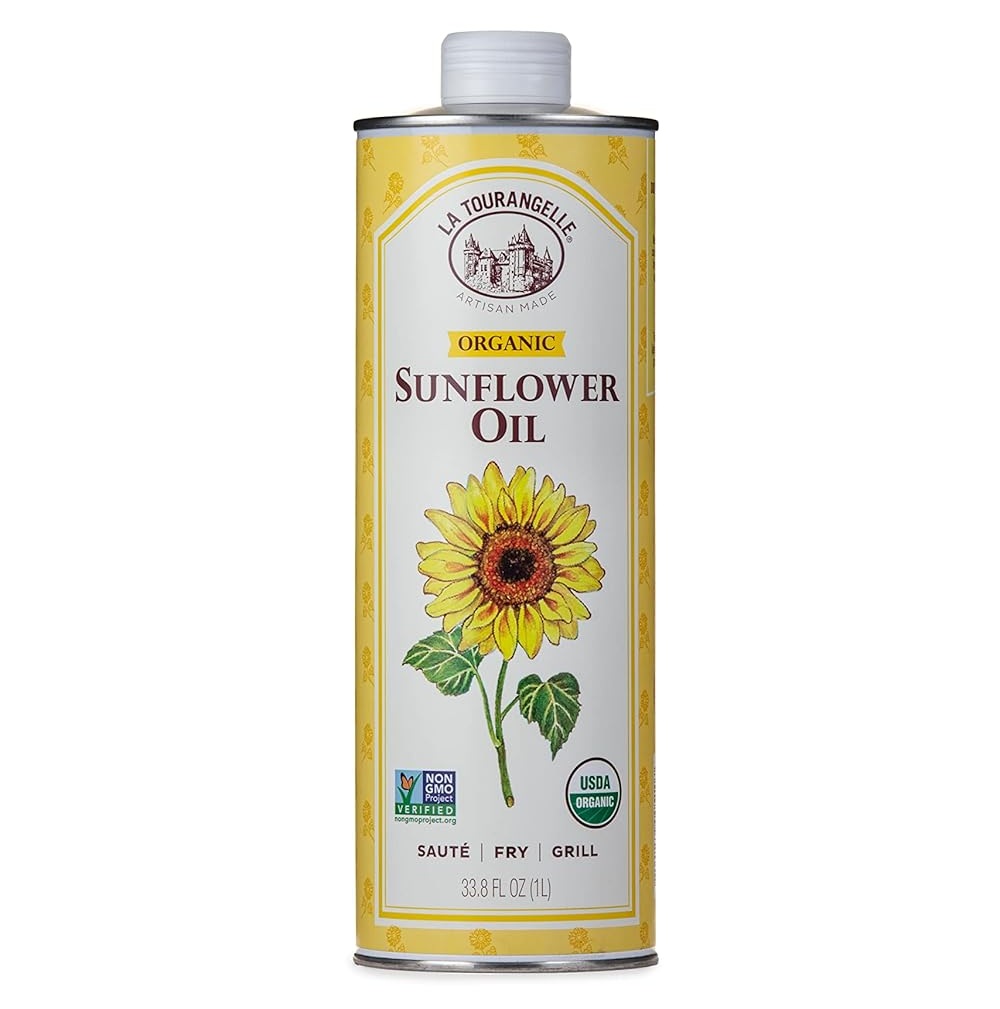
- Smoke Point: High-oleic varieties can have smoke points of about 450°F (232°C).
- Flavor Profile: Neutral, light taste.
- Nutritional Benefits: High in vitamin E and monounsaturated fats (in high-oleic forms).
- Best Uses: High-heat cooking, baking, and frying.
Clarified Butter (Ghee)
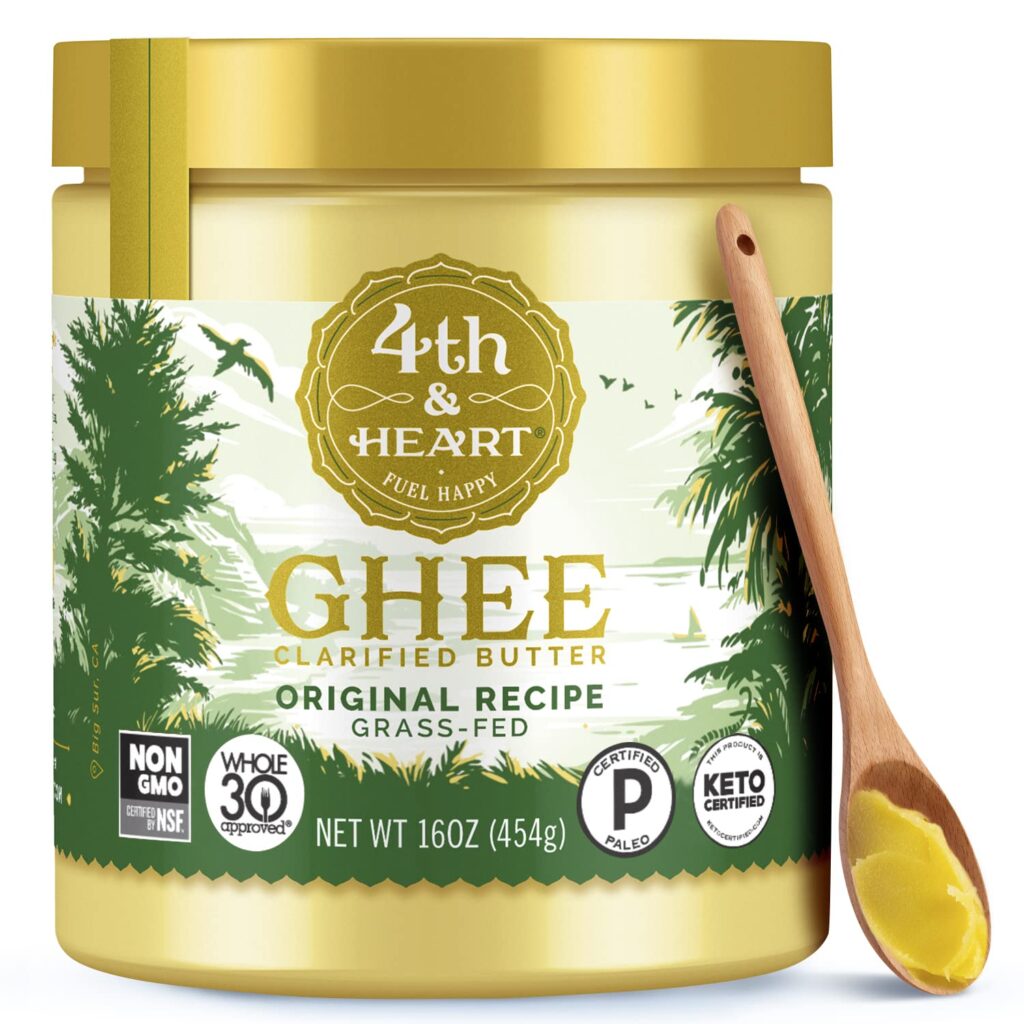
- Smoke Point: Approximately 485°F (252°C).
- Flavor Profile: Rich, slightly nutty taste.
- Nutritional Benefits: A form of butter from which milk solids and water have been removed, leaving mostly fats, including saturated fats. Contains vitamins A, D, E, and K in small amounts.
- Best Uses: High-heat sautéing, Indian cooking, baking, or as a butter substitute for lactose-intolerant individuals (it is not entirely lactose-free but often easier on digestion).
How to Choose the Right Oil for Cooking
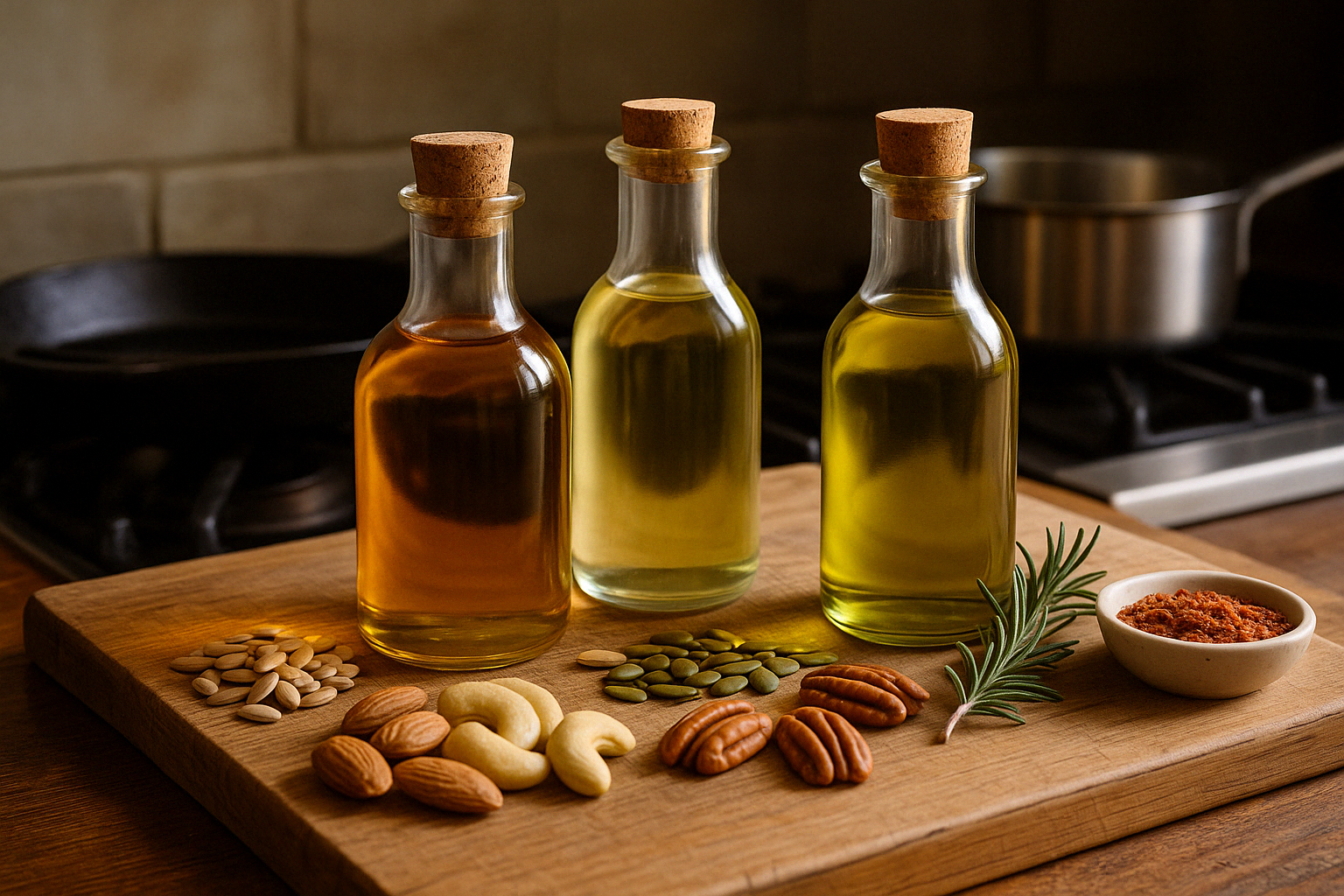
Choosing the right cooking oil requires considering several factors:
- Smoke Point: For high-heat methods like frying or stir-frying, select oils with higher smoke points (avocado, refined olive oil, peanut oil). For lower heat or raw applications (dressings, dips), extra virgin olive oil or flaxseed oil can be excellent choices.
- Flavor Profile: Bold oils like sesame or extra virgin olive oil can enhance the taste of certain dishes, but may clash with others. Neutral oils (grapeseed, avocado, refined olive oil) are better when you don’t want the oil’s flavor to dominate.
- Fat Composition: Opt for oils rich in monounsaturated or polyunsaturated fats. Limit oils high in saturated fats, like coconut oil, if you already consume significant amounts of saturated fats from other sources.
- Nutritional Concerns: If you have specific health goals (e.g., heart health), favor oils high in omega-3s and omega-9s.
- Ethical and Environmental Considerations: Some oils, like palm oil, can raise concerns about sustainability and deforestation. You may want to consider the environmental impact of your oil choices as well.
Cooking Tips for Using Healthy Fats
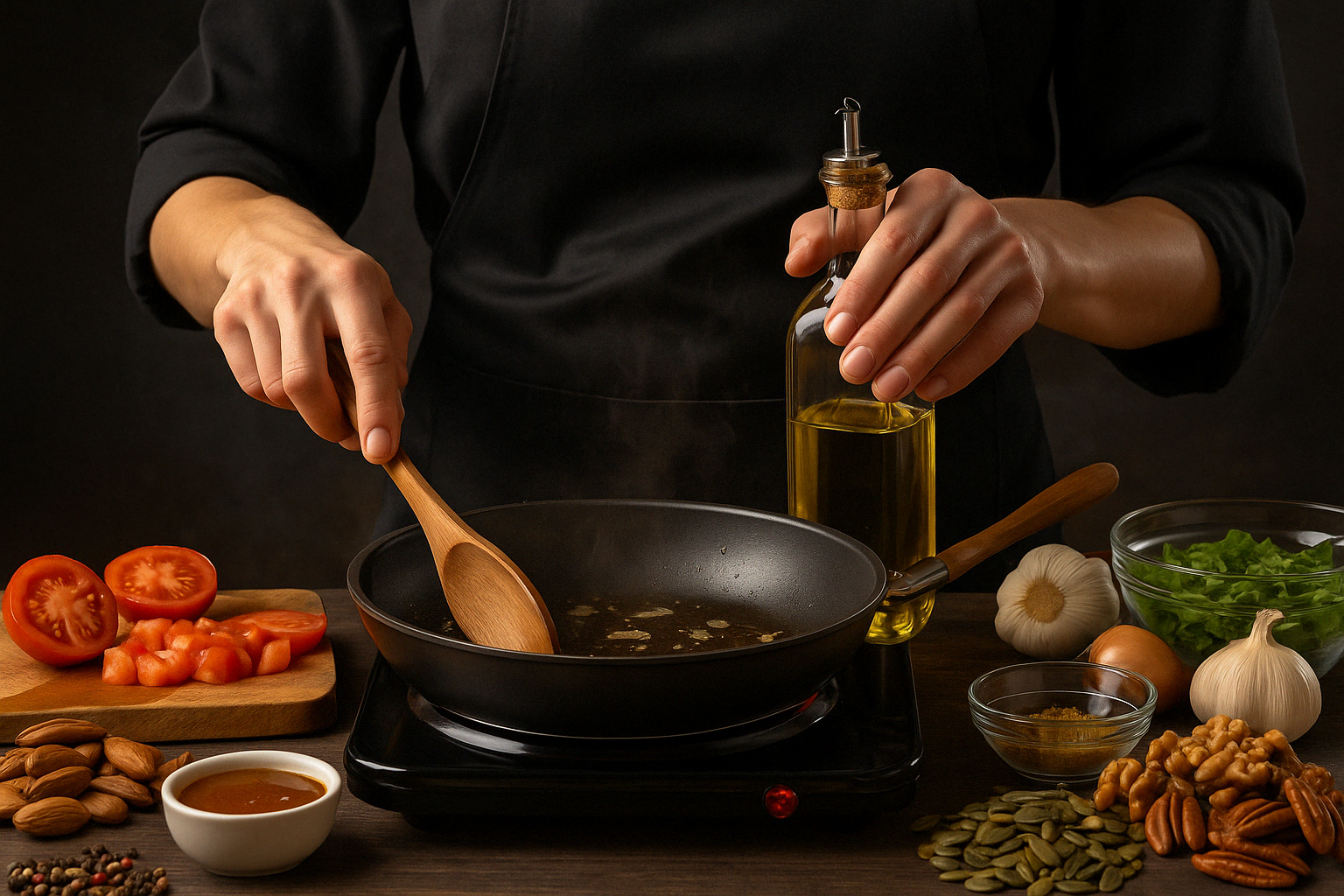
Even when using healthy fats, how you cook with them is just as important as which fats you choose. Consider the following tips:
- Avoid Overheating: Once an oil reaches its smoke point, it begins to break down, losing nutritional value and potentially forming harmful compounds. Use oils appropriate for the cooking method.
- Use a Food Thermometer: If you frequently fry or sauté, a kitchen thermometer can help you maintain the right temperature without surpassing the oil’s smoke point.
- Store Oils Properly: Light, heat, and air can degrade oils. Keep them in a cool, dark place, and ensure lids are tightly sealed. For certain oils (e.g., flaxseed oil), refrigeration is recommended to prevent rancidity.
- Mind Your Portions: Healthy fats are still calorie-dense, providing 9 calories per gram. Moderation is key, even for heart-healthy oils.
- Experiment with Flavor Combinations: Pair strong-flavored oils (like toasted sesame) with complementary cuisines (Asian dishes). Use neutral oils (like grapeseed) when you want the flavor of the dish’s ingredients, such as herbs and spices, to shine.
- Combine Oils and Techniques: You can mix oils or use different cooking methods in a single recipe. For instance, you might sauté onions in olive oil, then finish a dish with a drizzle of basil-infused oil.
How to Infuse Your Own Herbal Oils
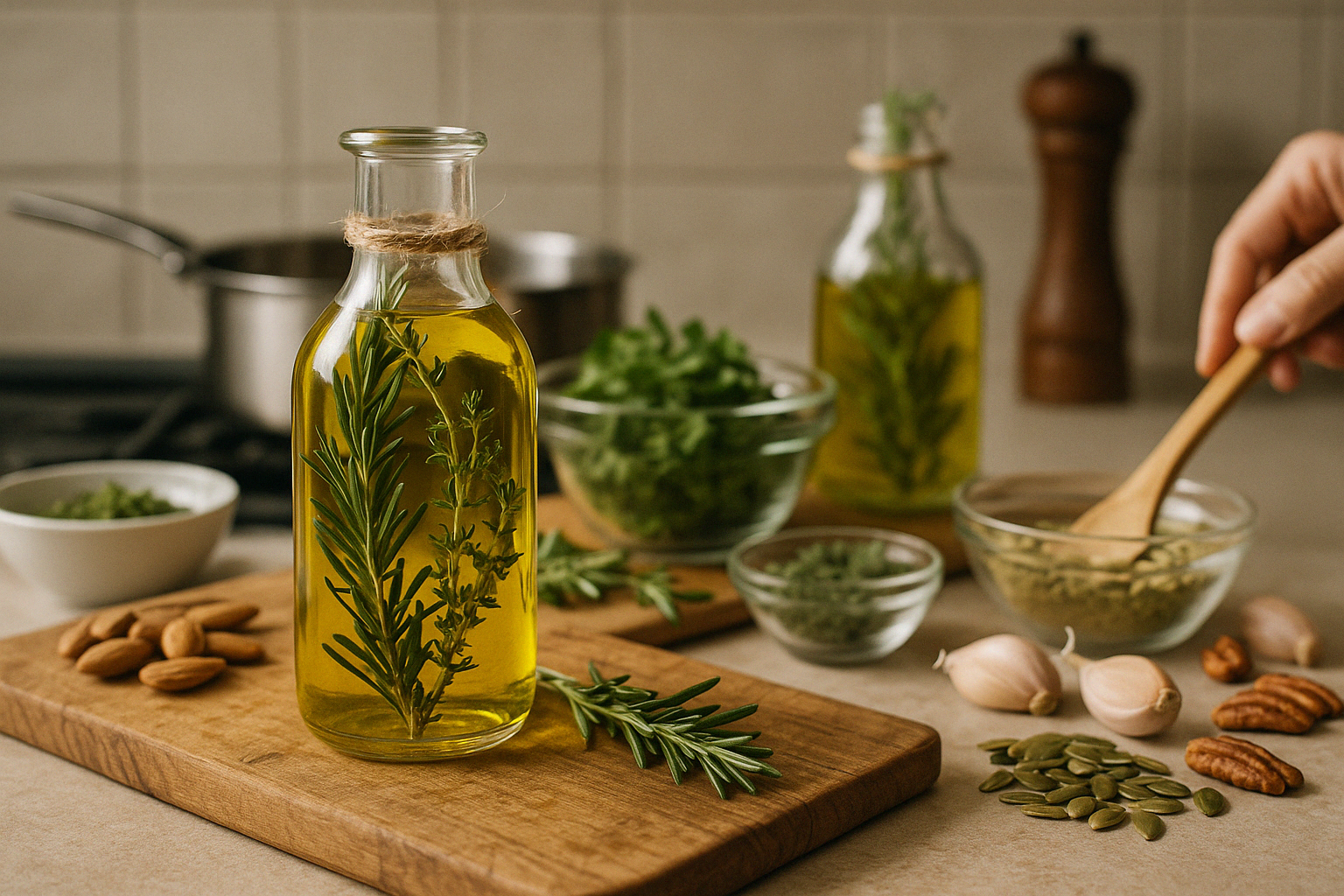
Creating homemade herbal oils can be a satisfying way to ensure quality, control flavor intensity, and enjoy fresh herbs. Here’s a simple step-by-step guide:
- Choose Your Base Oil
Select a high-quality oil with a flavor profile that complements the herbs. Olive, avocado, and grapeseed oils are popular choices. - Select Your Herbs
- Fresh Herbs: Wash, pat them dry, and allow them to air-dry thoroughly. Any water left on the herbs can encourage bacterial growth.
- Dried Herbs: These are less prone to spoilage and often yield a more concentrated flavor.
- Infuse at the Right Temperature
- Cold Infusion: Place herbs and oil in a clean, airtight container. Let it rest for 1–2 weeks in a cool, dark place, shaking occasionally to distribute flavors.
- Warm Infusion: Gently heat the oil and herbs together over low heat (below the smoke point) for 30–60 minutes, being careful not to fry the herbs. Cool and strain.
- Strain
After infusing, strain the mixture through a fine mesh sieve or cheesecloth to remove the herbs. This step helps extend shelf life and improves texture. - Store
Transfer the infused oil to a sterile, dark glass bottle. Label it with the date and keep it in a cool, dark area (or the refrigerator) to maintain freshness.
Safety Note: Garlic, fresh herbs, and chili peppers in oil can pose a risk of botulism if not handled properly. Always follow reputable guidelines for acidifying or refrigerating your homemade infusions to minimize risks.
Storing and Preserving Herbal Oils
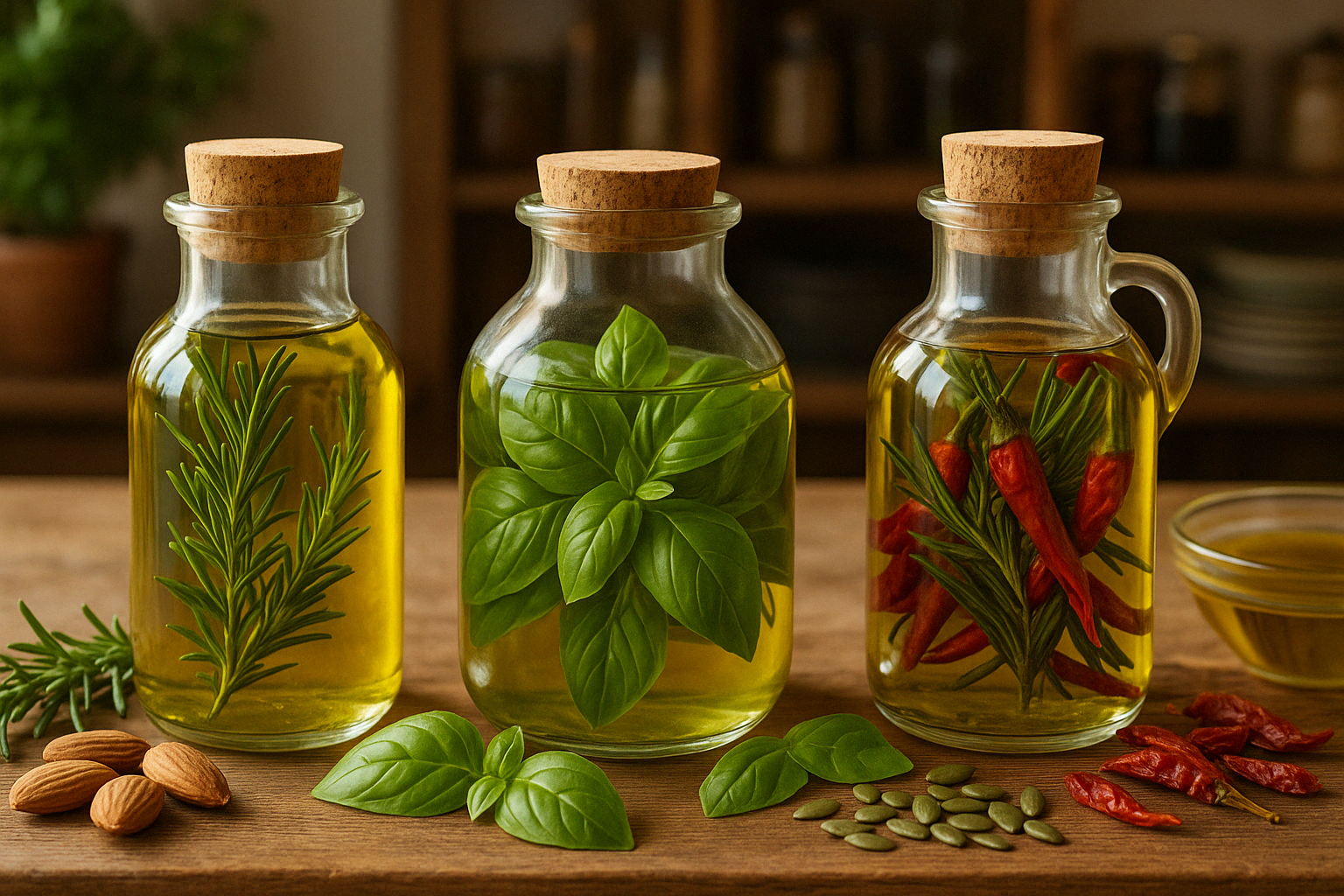
To preserve quality and extend the shelf life of your infused herbal oils:
- Refrigeration: Especially if you use fresh herbs, refrigeration can slow the growth of bacteria.
- Dark Containers: Use amber or dark green glass bottles to block out light.
- Use Within a Reasonable Time: Infused oils often last about 2–4 weeks in the refrigerator, though some can last longer if made with dried herbs and handled carefully.
- Label Clearly: Keep track of the infusion date and herb type so you don’t risk consuming it past its prime.
Balancing Your Diet with Healthy Fats
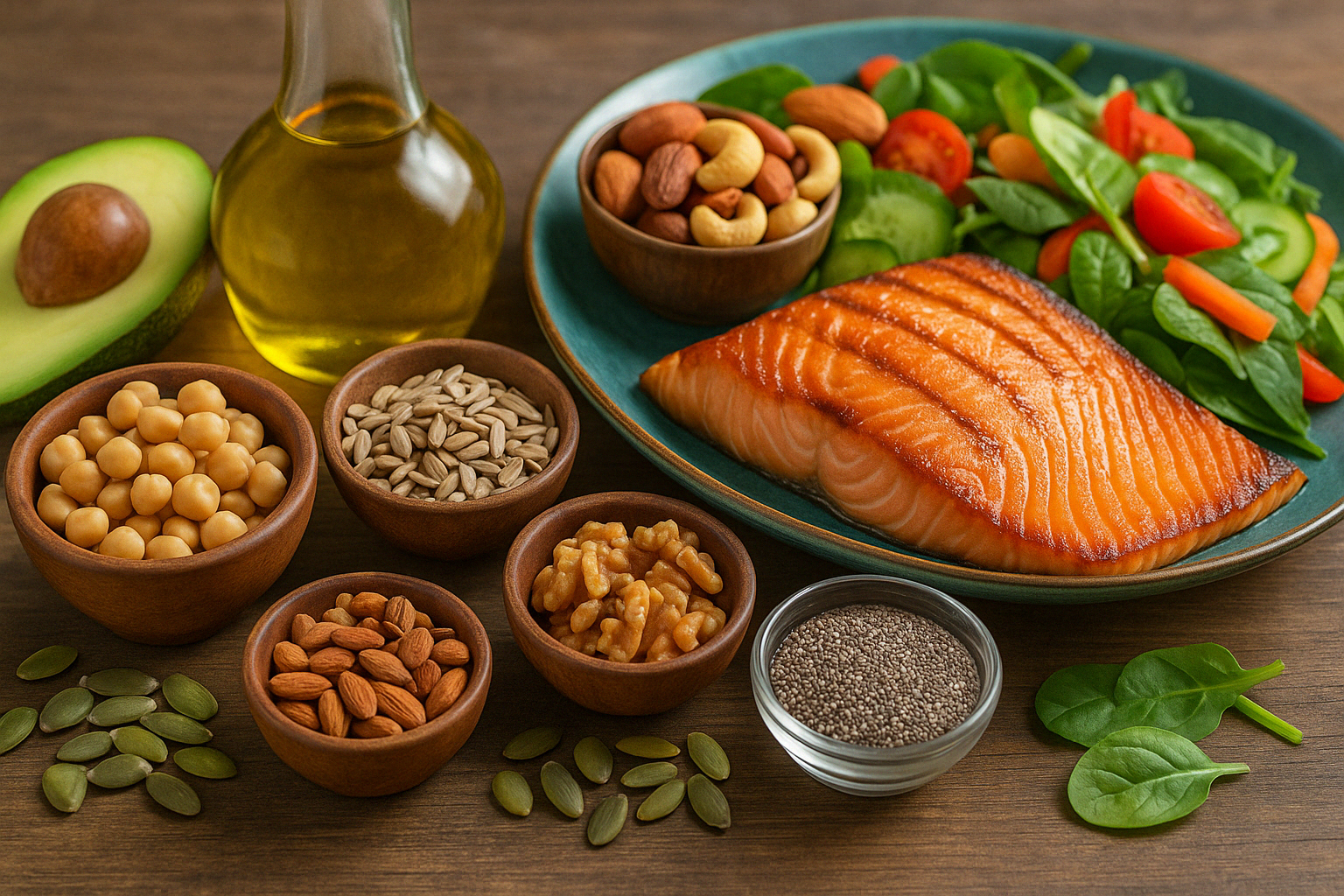
Fats are best consumed as part of a balanced diet that includes lean proteins, whole grains, vegetables, fruits, and adequate hydration. Some practical ways to maintain this balance:
- Portion Control: Measure out oils and fats rather than pouring them freely. A tablespoon here and there can quickly add up in calories.
- Variety: Rotate your fat sources. For instance, use extra virgin olive oil in salad dressings one day, and cook with avocado oil the next. Enjoy a serving of fatty fish or a handful of walnuts as snacks.
- Pair with Fiber-Rich Foods: Consuming fats alongside fiber (vegetables, whole grains, legumes) can enhance satiety and help regulate blood sugar levels.
- Consider Omega-3 Supplements: If you do not consume much fish or other omega-3–rich foods, consider high-quality fish oil or algae-based supplements to ensure you meet your essential fatty acid needs.
- Balance Omega-6 and Omega-3: The typical Western diet tends to have too many omega-6 fats relative to omega-3s. Strive to incorporate more omega-3–rich foods (fatty fish, flaxseeds, chia seeds) and moderate your intake of omega-6–heavy oils (corn, soybean).
Common Myths About Fats
With so much information online, it’s easy to come across misleading or oversimplified statements about fats. Let’s debunk a few common myths:
- Myth: “All fats make you gain weight.”
Reality: Excess calories from any source—fats, carbohydrates, or proteins—can lead to weight gain. Healthy fats can actually promote satiety and may help maintain a balanced diet when consumed sensibly. - Myth: “Low-fat diets are the healthiest.”
Reality: Extremely low-fat diets can deprive the body of essential nutrients. The quality of the fat is more important than the sheer quantity. Good fats are crucial for hormones, brain function, and nutrient absorption. - Myth: “Coconut oil is always healthy.”
Reality: Coconut oil has some potential benefits due to lauric acid, but it is also high in saturated fat. Moderation is key. Overconsumption may raise LDL cholesterol in individuals sensitive to dietary saturated fats. - Myth: “Butter is bad, margarine is good.”
Reality: Margarine historically contained high levels of trans fats, although formulations have changed. Both butter and margarine can fit in a balanced diet, but reading labels and using them in moderation is essential. - Myth: “You should never cook with olive oil.”
Reality: While extra virgin olive oil has a relatively lower smoke point, it is still suitable for low to medium-heat cooking. Refined or “light” olive oil can be used for higher-heat applications.
Conclusion
Dietary fat is a complex topic that has been oversimplified for decades, leading many people to fear fats in general. Yet, the latest nutrition science clearly shows that quality and balance matter much more than a one-size-fits-all approach. Fats are not merely a source of calories; they are essential components of a healthy diet, necessary for hormonal balance, nutrient absorption, and cellular health.
By prioritizing monounsaturated and polyunsaturated fats, especially those rich in omega-3s, and moderating saturated fats, you can support heart health and overall wellness. Keep a close eye on trans fats, which offer no health benefits and can significantly increase the risk of chronic diseases.
Herbal oils present a flavorful way to incorporate healthier fats and beneficial plant compounds into your meals. Whether you choose rosemary-infused olive oil or basil-infused avocado oil, these oils can elevate simple dishes and introduce new, vibrant tastes to your cooking routine. Keep in mind smoke points and storage conditions for these oils to retain their maximum flavor and nutritional value.
As you plan your weekly meals, consider rotating through different healthy fat sources—avocados, nuts, seeds, fatty fish—and explore creating homemade herbal oil infusions for an added layer of taste. The emphasis should be on variety, moderation, and balance. Pairing healthy fats with nutrient-dense foods (whole grains, leafy greens, and legumes) ensures that you obtain all the essential vitamins, minerals, and macronutrients your body needs.
Ultimately, the goal is to create a sustainable, enjoyable way of eating that nourishes your body and keeps your meals exciting. Armed with the knowledge of healthy vs. unhealthy fats and a few tips on how to incorporate flavorful herbal oils into your cooking, you can confidently embark on a culinary journey that benefits both your taste buds and your long-term health.

